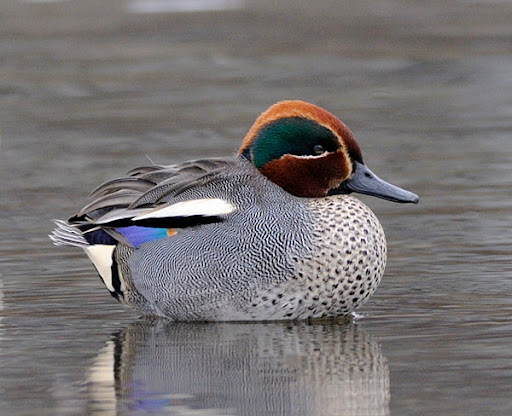Common Teal (Eurasian Teal)

Scientific Name
Anas crecca
Alternative Names
Common Teal, Eurasian Green-winged Teal
Measurements
| Feature | Male | Female |
|---|---|---|
| Length | 34–43 cm (13–17 in) | 34–43 cm (13–17 in) |
| Weight | ~360 g (13 oz) | ~340 g (12 oz) |
| Wingspan | 53–59 cm (21–23 in) | 53–59 cm (21–23 in) |
Status
A widespread duck across Europe and Asia. Classified as Least Concern by the IUCN due to its large population, though wetland loss still affects some areas.
Identification
One of the smallest dabbling ducks. Males in breeding season have a chestnut head with a dark green eye patch edged in cream, a grey body, and a white stripe on the side. Females are mottled brown with a small green speculum on the wing and resemble a tiny female mallard. Both sexes have a green speculum that reflects in flight.
Voice
Males make a clear, whistling “crick” sound. Females give a soft quack or “keh” call.
Diet
Feeds on seeds, aquatic plants, insects, small crustaceans, and mollusks. Dabbles on the water surface or tips forward to reach food. In winter, it eats mostly seeds and grains.
Distribution
Breeds across Europe and northern Asia (Palearctic region). Winters in southern Europe, North Africa, the Middle East, South Asia, and parts of East Asia.
Habitat
Prefers shallow freshwater wetlands, lakes, ponds, marshes, and bogs during breeding. In winter, often seen in brackish water, estuaries, and sheltered coastal areas.
Breeding
Nests on the ground near water, hidden in grass or reeds. Lays 8–11 eggs. The female incubates for about 21–23 days. Ducklings leave the nest shortly after hatching and are cared for by the mother until they fledge.
Wintering
Migratory. Moves south in autumn to warmer regions with unfrozen wetlands. Forms large flocks and often joins other small ducks.
Conservation
Not endangered. Protected under international agreements like AEWA. Main threats include wetland drainage, pollution, and habitat disturbance, but overall populations remain stable.
